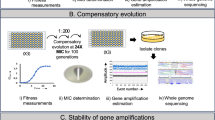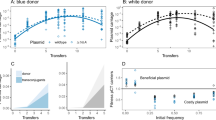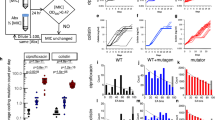Abstract
The emergence of mobile colistin resistance (mcr) threatens to undermine the clinical efficacy of the last antibiotic that can be used to treat serious infections caused by Gram-negative pathogens. Here we measure the fitness cost of a newly discovered MCR-3 using in vitro growth and competition assays. mcr-3 expression confers a lower fitness cost than mcr-1, as determined by competitive ability and cell viability. Consistent with these findings, plasmids carrying mcr-3 have higher stability than mcr-1 plasmids across a range of Escherichia coli strains. Crucially, mcr-3 plasmids can stably persist, even in the absence of colistin. Recent compensatory evolution has helped to offset the cost of mcr-3 expression, as demonstrated by the high fitness of mcr-3.5 as opposed to mcr-3.1. Reconstructing all of the possible evolutionary trajectories from mcr-3.1 to mcr-3.5 reveals a complex fitness landscape shaped by negative epistasis between compensatory and neutral mutations. Our findings highlight the importance of fitness costs and compensatory evolution in driving the dynamics and stability of mobile colistin resistance in bacterial populations, and they highlight the need to understand how processes (other than colistin use) impact mcr dynamics.
Similar content being viewed by others
The first discovery of plasmid-borne mcr-1 gene encoding colistin resistance in 2015 [1], has raised major international concerns for human health as their dissemination within and between species can rapidly confer wide-spread resistance to colistin, a last-resort antibiotic deployed against carbapenem-resistant pathogens. Antibiotic resistance is usually associated with a fitness cost [2, 3], and this cost helps to limit the spread and maintenance of resistance, for example by reducing the ability of bacteria to transmit between hosts [2, 4, 5]. In this case, the expression of mcr-1 in Escherichia coli confers a fitness cost, virulence loss and changes in innate immune response [6]. These changes suggest that restricting colistin use, for example by banning the use of colistin as a growth promoter, could lead to the decline of mcr-1.
A new transferable mcr-3.1 gene with only 45.0% nucleotide homology to mcr-1, was firstly identified on an IncHI2-type plasmid in an E. coli isolate from pig faeces from China in June 2017 [7]. Two variants of mcr-3 (mcr 3.1 and mcr 3.5) are now highly prevalent in South East Asia (unpublished data), but despite their clinical importance, the impact of mcr-3 expression on bacterial fitness is still unknown. To test the impact of mcr-3 expression on bacterial fitness, we cloned mcr-3 into an inducible expression vector using a strategy as previously described to measure the cost of mcr-1 [8] (details of strains and plasmids are listed in Supplementary Table 1). Consistent with our previous work, induction of mcr expression slowed the growth of E. coli Top10 relative to uninduced controls, demonstrating a fitness cost by mcr expression (Fig. 1a). Both mcr-3 variants imposed a smaller fitness cost than mcr-1, but the expression of mcr-3.5 was less costly than that of mcr-3.1. We then assessed the effect of MCR-3 on cell viability via LIVE/DEAD® staining with confocal laser scanning microscopy imaging (details see in Supplementary File 1). A minimal reduction in bacterial viability was observed in E. coli TOP10 (mcr-3.5/pBAD), compared with that of E. coli TOP10 (mcr-3.1/pBAD) (~3 vs 9%, p = 0.0002, see Supplementary Fig.1 and Supplementary Table 4). Furthermore, we investigated whether expression of MCR-3.1 and MCR-3.5 affects bacterial morphology by using transmission electron microscopy. The control strain, E. coli TOP10 (pBAD alone), showed normal cellular characteristics with a multi-layered cell outer membrane and cytoplasmic granular density (Supplementary Fig. 2). However, a demonstrable loss of electron density and significant impaired cell wall integrity were observed in both MCR-3.1- and MCR-3.5-producing E. coli TOP10 cells (Supplementary Fig. 2), which is consistent with our previous findings with mcr-1 expression [8].
a Effects of the expression of three mcr-variants, mcr-1, mcr-3.1 and mcr-3.5 on bacterial growth rate in vitro. The expression of mcr- genes was induced by 0.2% (w/v) L-arabinose and bacterial density was measured by microplate reader at every 1 h. The data represent the mean and SD (n = 3). b The adaptive landscape of colistin resistance mcr-3.5 conferred by three mutations in mcr-3.1 gene. Each node displays the amino acid substitution (M23V, A457V and T488I) and its average fitness. This figure shows the fitness landscape connecting MCR3.1 to MCR3.5. Possible evolutionary trajectories are shown with arrows and the fitness of each genotype is given followed by the standard error of fitness. We tested the fitness effect of each mutation using a t-test followed by a Bonferroni correction for multiple (n = 12 tests). Blue and red arrows show mutations that significantly increase or decrease fitness, respectively, and grey arrows show neutral mutations that do not alter fitness (details in Supplementary Table 6). c Epistatic interactions among MCR-3 mutants: this figure shows the observed (blue) and expected (grey) fitness of MCR mutants containing at least two substitutions (+/− S.E). Expected fitness values were calculated using a multiplicative model of fitness and we used the method of propagation of errors to determine the error in expected fitness estimates (Supplementary Table 7).
It is well-established that compensatory mutations can mitigate the fitness cost associated with the expression of antibiotic resistance genes, and therefore allowing resistance genes to be stably maintained in bacterial populations [2]. mcr-3.1 and 3.5 differ from each other by only three amino-acid substitutions (M23V, A457G, T488I), suggesting that recent compensatory evolution has mitigated the cost of mcr3 expression. To further understand the compensatory evolution in MCR-3, we reconstructed all of the possible variations between MCR-3.1 and MCR-3.5 (primers and methods shown in Supplementary Tables 2 and 3). Substitutions A457V and T488I had strong compensatory effects when they were inserted into MCR-3.1, increasing fitness by up to 45% (Fig. 1b). However, the double substitution of A457V and T488I did not demonstrate a higher fitness than either of the single mutants, demonstrating negative epistasis between these substitutions (Supplementary Table 7). The remaining substitution (M23V) is either neutral or mildly deleterious. These epistatic interactions generate a complex fitness landscape with two isolated peaks with fitness rates of ~1.3 and 1.45, respectively (Fig. 1b,c). Crucially, only 1 of the 6 possible evolutionary trajectories linking MCR-3.1 to MCR-3.5, gives monotonically increasing fitness (i.e. no deleterious mutation) and this trajectory involves a combination of neutral mutations (M23V, T488I) and only a single compensatory mutation (A457V) (Fig. 1b and Supplementary Tables 5–7). These data clearly show that compensatory mutations can mitigate the cost of MCR-3 expression, but they also highlight the role that epistasis plays in the evolution of MCR enzymes. A key challenge for future work will be to understand how these substitutions alter the substrate binding and/or catalytic activity of MCR-3.
Given that MCR-3 imposes a lower fitness cost than MCR-1, then it follows that MCR-3 should have a higher stability than MCR-1. To test this hypothesis, we passaged cultures of three wild-type E. coli strains that harbour both MCR-3 and MCR-1 plasmids over 14 days in the presence and absence of colistin (see details in Supplementary File 1). The dynamics of individual plasmid/host strain combinations were complex, but the ratio of mcr-3/mcr-1 plasmids consistently increased over time in all three strains, consistent with the low cost of MCR-3 carriage (Fig. 2a and Supplementary Tables 8–12). The dynamics of plasmid populations are complex, but the key difference appears to be that mcr-1 plasmids were slowly lost, whereas mcr-3 plasmid populations recovered after an initial period of decline. Interestingly, mcr-3 plasmids were able to increase in frequency in the absence of colistin exposure.
a The dynamic changes of mcr-1 and mcr-3 plasmids’ copy numbers in wild-type strains. To model the change in mcr-1 or mcr-3 copy number across time, we used polynomial regression. The difference in threshold cycle (ΔCt) between either mcr-1 or mcr-3 and chromosomally encoded gene rpoB were used to calculate their relative copy numbers over time (see Methods in Supplementary File 1). In addition, the difference in threshold cycle (ΔCt) between mcr-3 or mcr-1, which is equivalent to log2 of relative copy number, were used as a response variable. In this figure, four fixed variables and their interactions were used as predictors: Strain (PN42, PN4 or PN24), genes (mcr-1 and mcr-3), generations and Colistin (colistin presence/absence). Each strain included three independent replicates which were measured repeatedly over the course of the experiment. For a full model incorporating the effect of host strain, particular gene and presence of colistin, see Supplementary Tables 9–13. The analysis was performed using R (version 3.5.1) and packages lme4 (version 1.1–17) and lmerTest (version 3.0-1). b The dynamic changes of mcr-1 and mcr-3 genes/plasmids in E. coli J53 strain. We used threshold cycle values (CT) measured by qPCR in order to estimate relative copy number (see Methods). Two fixed variables and their interactions were used as predictors in this figure: cultures (monoculture vs mixed cultures), genes (mcr-1 and mcr-3), generations and Colistin (colistin presence/absence). For a full model incorporating the effect of culture, particular gene and presence of colistin, see Supplementary Tables 13–15. The analysis was performed using R (version 3.5.1) and packages lme4 (version 1.1-17) and lmerTest (version 3.0-1).
To further test the effect of MCR production on plasmid stability, we generated tranconjugants of E. coli J53 carrying either an mcr-1 plasmid or an mcr-3 plasmid. The abundance of both the mcr-1 and mcr-3 plasmids declined in transconjugant monocultures, demonstrating that these plasmids impose a fitness cost (Fig. 2b and Supplementary Tables 13–15). Plasmid frequency also decreased over time when the transconjugants were co-cultured. However, the mcr-3 plasmid had a higher stability than the mcr-1 plasmid under direct competition, which is consistent with a reduced fitness cost of MCR-3. Our results suggest that the long-term persistence of resistance is influenced by both the fitness effects (e.g. mcr-3-positive plasmids carry a smaller cost than that of mcr-1- plasmids, see in Fig. 1), and plasmid dynamics (e.g. recovery of mcr-3-positive plasmids in spite of costs of gene, see in Fig. 2). Interestingly, the short-term dynamics of the resistance genes can be largely understood in terms of fitness effects, but plasmid dynamics become more important over the longer term.
There is little doubt that the use of colistin is a key driver for the emergence of colistin resistance. Large quantities of colistin have been used in food-producing animals for metaphylaxis or as growth promoters [1, 9, 10], and colistin is still considered a vital antibiotic for treating serious Gram-negative infections [6]. Interestingly, we found that the addition of low concentrations (2 mg/l) of colistin had little or no impact on the outcome of mcr-1 and mcr-3 plasmid dynamics (Supplementary Tables 8–15), suggesting that colistin is not the only factor influencing the spread and maintenance of mcr-carrying plasmids. Both competition models showed that both the host genotype and gene/plasmid characteristics can influence the long-term co-existence of mcr genes.
Understanding the drivers of stability of resistance genes in complex microbial communities is of great importance for predicting the fate of resistance genes and success of bacterial clones in response to ecological challenges (e.g. antibiotics). It is generally understood that the acquisition of antibiotic resistance genes in bacterial communities are deleterious, due to their fitness burden that limiting the spread of resistance genes in the bacterial populations [2, 3, 11]. However, bacteria can and adapt and evolve rapidly to persist in these changing environments through compensatory mutations [11, 12]. In this study, we provided evidence that the compensatory mutations found in mcr-3 can mitigate the fitness cost imposed by plasmid acquisition and significantly improve the retention of mcr-3-positive plasmids. Moreover, although the fitness burden cost occurred in the first 50 generations, both mcr-1 and mcr-3 genes can persist in mixed populations, and the relative abundance of mcr-3-carrying plasmids increased over time, suggesting that the burden cost are alleviated through compensatory adaptations. In particular, associations exist between resistance genes and bacterial communities via vertical and horizontal transfers, and as mcr-1 and mcr-3 plasmids are highly transferable (conjugation rates are as high as 10−4, unpublished data), there is the potential risk of mcr-1 and mcr-3 genes being rapidly disseminated throughout bacterial communities. In conclusion, our study reveals that (i) both MCR-1 and MCR-3 genes produce fitness costs during bacterial competition; (ii) the costs can be alleviated through compensatory mutations; (iii) both fitness costs and plasmid dynamics play an important role in the persistence of resistance genes within bacterial communities; (iv) our data also highlight the importance of the genetic context of resistance genes/plasmids for understanding the long-term dynamics of resistance.
References
Liu Y-Y, Wang Y, Walsh TR, Yi L-X, Zhang R, Spencer J, et al. Emergence of plasmid-mediated colistin resistance mechanism MCR-1 in animals and human beings in China: a microbiological and molecular biological study. Lancet Infect Dis. 2015;16:161–8.
Andersson DI, Hughes D. Antibiotic resistance and its cost: is it possible to reverse resistance? Nat Rev Microbiol. 2010;8:260–71.
Vogwill T, MacLean RC. The genetic basis of the fitness costs of antimicrobial resistance: a meta-analysis approach. Evolut Appl. 2015;8:284–95.
Bell G, MacLean C. The search for ‘evolution-proof' antibiotics. Trends Microbiol. 2018;26:471–83.
Schulz zur Wiesch P, Engelstadter J, Bonhoeffer S. Compensation of fitness costs and reversibility of antibiotic resistance mutations. Antimicrob Agents Chemother. 2010;54:2085–95.
Kluytmans J. Plasmid-encoded colistin resistance: mcr-one, two, three and counting. Euro Surveill. 2017;22 pii: 30588.
Yin W, Li H, Shen Y, Liu Z, Wang S, Shen Z, et al. Novel plasmid-mediated colistin resistance gene mcr-3 in Escherichia coli. MBio. 2017;8 pii: e00543–17.
Yang Q, Li M, Spiller OB, Andrey DO, Hinchliffe P, Li H, et al. Balancing mcr-1 expression and bacterial survival is a delicate equilibrium between essential cellular defence mechanisms. Nat Commun. 2017;8:2054.
Carrique-Mas JJ, Trung NV, Hoa NT, Mai HH, Thanh TH, Campbell JI, et al. Antimicrobial usage in chicken production in the Mekong Delta of Vietnam. Zoonoses Public Health. 2015;62:70–8.
EMA. EMA updates its advice on the use of colistin in animals. Vet Rec. 2016;179:131–2.
MacLean RC, San Millan A. The evolution of antibiotic resistance. Science. 2019;365:1082–3.
Hughes D, Andersson DI. Evolutionary consequences of drug resistance: shared principles across diverse targets and organisms. Nat Rev Genet. 2015;16:459–71.
Acknowledgements
This work was supported by MRC grant DETER-XDR-CHINA-HUB (MR/S013768/1). DOA benefits a Geneva University Hospitals (HUG) and Swiss National Science Foundation (P300PB_171601) overseas fellowship. CM is supported by Wellcome Trust Grant 106918/Z/15/Z.
Author information
Authors and Affiliations
Corresponding authors
Ethics declarations
Conflict of interest
The authors declare that they have no conflict of interest.
Additional information
Publisher’s note Springer Nature remains neutral with regard to jurisdictional claims in published maps and institutional affiliations.
Supplementary information
Rights and permissions
Open Access This article is licensed under a Creative Commons Attribution 4.0 International License, which permits use, sharing, adaptation, distribution and reproduction in any medium or format, as long as you give appropriate credit to the original author(s) and the source, provide a link to the Creative Commons license, and indicate if changes were made. The images or other third party material in this article are included in the article’s Creative Commons license, unless indicated otherwise in a credit line to the material. If material is not included in the article’s Creative Commons license and your intended use is not permitted by statutory regulation or exceeds the permitted use, you will need to obtain permission directly from the copyright holder. To view a copy of this license, visit http://creativecommons.org/licenses/by/4.0/.
About this article
Cite this article
Yang, Q.E., MacLean, C., Papkou, A. et al. Compensatory mutations modulate the competitiveness and dynamics of plasmid-mediated colistin resistance in Escherichia coli clones. ISME J 14, 861–865 (2020). https://doi.org/10.1038/s41396-019-0578-6
Received:
Revised:
Accepted:
Published:
Issue Date:
DOI: https://doi.org/10.1038/s41396-019-0578-6
This article is cited by
-
Comparative genomic analysis of Colistin resistant Escherichia coli isolated from pigs, a human and wastewater on colistin withdrawn pig farm
Scientific Reports (2023)
-
Longitudinal study of the mcr-1 gene prevalence in Spanish food-producing pigs from 1998 to 2021 and its relationship with the use of polymyxins
Porcine Health Management (2022)
-
Whole-population genomic sequencing reveals the mutational profiles of the antibiotic-treated Escherichia coli populations
Biologia (2022)
-
Quantifying the effects of antibiotic treatment on the extracellular polymer network of antimicrobial resistant and sensitive biofilms using multiple particle tracking
npj Biofilms and Microbiomes (2021)





